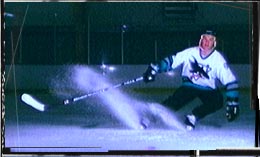|

|
Sharks Forward Jeff Friesen demonstrates the "hockey
stop." Click on "Quicktime" below to view the movie.
|
|

2.2 MB
|
|
Starting and Stopping on a Slippery Surface
Accelerating and decelerating on a slippery surface requires
a player to dig into the ice and push off from the surface.The sharp edges
on hockey skate blades can dig deeply into the ice, allowing a player to
accelerate quickly or stop on a dime using the "hockey stop."
The friction between the blade and the ice is minimized because the surface
of the ice is so slippery, and because only a small portion of the skate's
blade is actually in contact.
|
|
The Mechanics of Skating
NHL players can reach speeds in excess of 20 miles (32
km) per hour on the ice. Some speed skaters have been clocked at over 30
miles (48 km) per hour! What makes one player faster than another? A combination
of strength and mechanics help a skater move efficiently and quickly on
the ice. When accelerating, players dig their skates into the ice and lean
forward. They are exerting a strong force on the lower part of their bodies
by leaning forward. Gravity pulls down on a hockey player's center of mass
which "torques" him forward It is important to note that skaters
can only lean forward when they are accelerating. If they leaned forward
when traveling at a constant speed or decelerating, they would fall over.
|

|
Exploratorium physicist Thomas Humprey talks about
the mechanics of skating.
|
|
Who's really the fastest man on earth?
Skating, according to physicist Thomas Humphrey is "the
fastest way to travel on the surface of the earth on your feet." When
you run, your front foot slows you down every time it hits the ground. In
skating, one skate pushes and the other skate glides--there is very little
friction to slow you down. Speed skater Hiroyasu Shimizu of Japan can travel
500 meters in just 35.39 seconds, an average speed of 14.13 meters per second
or 31.6 miles per hour. In comparison, Canadian runner Donavan Bailey sprints
100 meters in 9.84 seconds for an average speed of 10.2 meters per second
or 22.8 miles per hour.
|
|

|
Steve Millard talks about the importance of technique
in skating.
|
|
Strength vs. Technique
How much of skating is strength and how much of it is mechanics
or technique? It's difficult to draw the line. Sharks player Doug Bodger
thought both were important but strength was key. Conditioning Coach Steve
Millard agreed that both were important but thought mechanics was the more
important of the two.
|
|
Everyone that we talked to thought that the only way to improve
your skating was to practice. Bicycles, swimming, and even weights were
mentioned as good "cross-training" activities, but apparently
there is no replacement for the act of skating itself. Sharks Forward Todd
Ewin told us, "If you don't skate, you'll find that you'll lose it
quickly--it's one of the few sports...where you'll lose the technique. We
take about 2 or 3 weeks off in the summer and that's it." Players and
coaches agree that to make it in the NHL you need both strength and good
skating technique. Apparently practice throughout the year is also important.
|
|
Click the "forward"
button below to continue.
|

©
Exploratorium
|